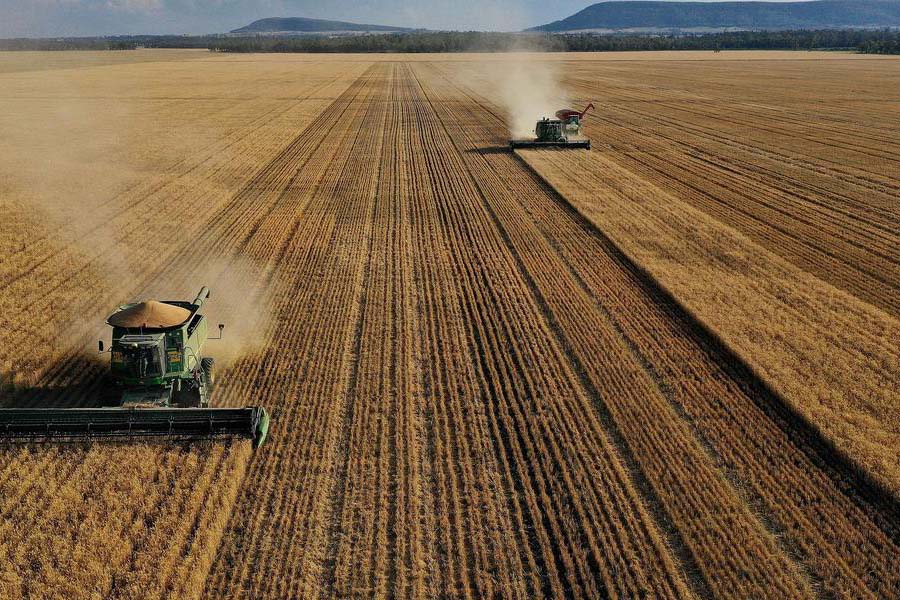Transformation in the agricultural sector is crucial for the Democratic Republic of the Congo (DRC) since it has the potential to significantly increase both GDP and national revenue. The agricultural sector accounts for the bulk of DRC’s workforce and most of the country’s value-added output. Conflict and the government’s gradual disengagement from supporting agricultural activity have combined to make agriculture the least productive sector in the Democratic Republic of the Congo (DRC).
Farmers rely on antiquated inputs and techniques that are based on a technology that is, at best, primitive. Lack of infrastructure, most of which was destroyed during political wars, also results in high transaction costs in agriculture. Weak agricultural output leads to precarious, low-paying work. Raising incomes for the poor requires a shift in agricultural policy, and the first step in this process is to increase agricultural output through proper agricultural machinery. The reason for this is that a rise in agricultural production “pushes” workers out of the industry and raises farmers’ actual earnings, while simultaneously “pulling” employment in industries that rely on agricultural inputs and expanding the availability of affordable food.

Mechanization Strategy and Technological Change
The use of tractors and other agricultural machinery is an example of labor-saving technological development, whereas biological and chemical breakthroughs are at the center of land-saving technological change. In an effort to boost food production and cut down on poverty and malnutrition, policymakers enacted this kind of agricultural revolution. Since most small-scale farmers are economically disadvantaged and have a smaller endowment of resources than larger-scale farmers, they must be at the heart of any agricultural transformation plan considered to be effective. In other words, as compared to wealthy families, poorer ones benefit from a superior model for agricultural modernization.
Technology advancements that rely on the application of capital are skill-biased in the sense that they tend to benefit those with more relevant experience and education. Mechanization and use of agricultural machinery decrease the need for unskilled and semiskilled labor in rural areas while increasing the need for highly skilled individuals in those same areas. It would seem that high-capital technologies and the need for highly trained labor are mutually reinforcing in rural regions. Tractors, farm implements and chemical spraying operations need highly trained staff because of the decreased requirement for physical labor. Farmers and ranchers get better returns on their effort than their urban counterparts to do for the same level of expertise. In this case, low-skilled urban employees benefit more than their more highly skilled and semi-skilled urban counterparts.
Benefits of Farm Mechanization
Both the kind of farm electricity utilized and the crop cultivated have substantial impacts on production costs. Using motorized agricultural machinery services lowered production costs in agriculture, and output soared on mechanized farms. There are a number of problems that make manual farming difficult, including the prevalence of weeds, the high cost of labor, the lack of accessible transportation, and the fact that many young people would rather work in industries other than agriculture.
Thus, the use of agricultural machineries like tractors and farm implements is more economically viable than the employment of agricultural laborers. Farm mechanization increased the productive capacity of smallholder farms, which increased their earnings and reduced their unit production costs. Mechanization’s impact on DRC’s agricultural sector can be broken down into four categories: increased productivity with less labor, greater productivity with the same amount of inputs, quicker turnaround times for operations, and the introduction of more environmentally friendly production methods.
Technical Constraints to Mechanization
The lack of agricultural mechanization experts in producer-support organizations and at research levels is a significant barrier to the sharing of knowledge, the education of producers and consumers, and the development of new technologies, according to studies of farm mechanization. The government of the Democratic Republic of the Congo introduced motorized agricultural machinery, notably high-capacity tractors, without providing proper training for technicians and other beneficiaries, which has severely hampered the effectiveness of agricultural mechanization in the country. The government purchased agricultural machinery and gave them out to people and groups with little to no background in farm mechanization, despite the fact that it lacked a comprehensive mechanization program. Both technicians and owners have pointed out the resulting problems, such as frequent failures, a lack of replacement parts, a dearth of skilled workers, and a high cost of gasoline.
As a result, mechanization in the DRC should begin from the ground up by enabling small-scale and local actors to manufacture farm implements and agricultural machinery suited to local realities that could be changed and maintained locally with no or little foreign inputs.
Role of Tractors Provider
When it comes to the distribution of tractors and other agricultural machinery in DRC, tractor provider is by far the most prominent tractor dealer in DRC. The company supplying tractors to the Democratic Republic of the Congo has pledged to work toward improving agricultural farming practices in the nation. Thus, Tractors Provider is devoted to offering the agricultural industry of DRC high-quality agricultural machinery manufactured in Pakistan. Adopting modern agricultural farming practices, such as the use of automated agricultural machinery, increases a country’s ability to meet the needs of its people and increase exports.
